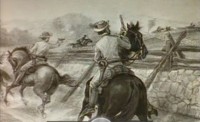[Another example, wonderfully documented, of the process by which a fictional tale was transformed into “historical fact” and a talking point that just won’t let go. Once factified, it can then be cited without fear of contradiction by all subsequent writers. The idea that Anse fought in a guerilla group called The Logan Wildcats has become a commonplace among feud writers. – RH]
What is a Logan Wildcat, other than a member of an athletic team from Logan High School? Well, to readers of recent Hatfield and McCoy feud books, a Logan Wildcat was someone who rode with Devil Anse Hatfield and his band of Rebel raiders during the last year of the Civil War.
The misuse of the name “Logan Wildcats” is not an important part of what is wrong with our history as written, but it is a good example of how our history is “made.” It is such a colorful name that a person writing a feud story would naturally grab it and go with it. But it was not always so.
The New York reporters, John Spears and T.C. Crawford wrote highly sensationalized books about the Hatfields and McCoys in 1888-9. Neither of them had any Logan Wildcats.
Charles Mutzenberg wrote his own supersized feud story, first in 1899, then a revised version in 1917. Mutzenberg had no Logan Wildcats prowling the border during the War.
In her 1940 book, “Big Sandy,” Jean Thomas says that Devil Anse was a Logan Wildcat (p.177), but she says that it was the regiment he originally joined, not a separate group of raiders during the war’s last year. Anse never appeared on the roster of the real Logan Wildcats. She says in the same paragraph that Ran’l McCoy joined the Union army, so we know how much credibility that book deserves.
L.D. Hatfield wrote his own collection of yarns, including the Abner Vance tale, in 1944, but he had no Logan Wildcats in Tug Valley.
Not even the newspaper and magazine reporter, Virgil Jones, in his highly fictionalized 1948 book, had the Logan Wildcats riding with Devil Anse. If such a moniker had indeed existed, surely Jones, with his practiced skill at appealing to a mass audience, would have picked it up.
- Elliott Hatfield wrote his “Hatfields” in 1974. This man, who claimed to know even the thoughts and words of the feud characters, had no Logan Wildcats.
The Logan Wildcats, as a unit led by Devil Anse Hatfield, entered the literature in 1976, with the publication of Truda McCoy’s “The McCoys.” McCoy, whose history was so garbled that she had Wall Hatfield tried, convicted and dead before he was even arrested, is the mother of the now famous “Logan Wildcats” of Devil Anse Hatfield.
Six years later, the West Virginia “Historian Laureate,” Otis Rice, had Truda McCoy’s Logan Wildcats in his book. At his first mention, he gives a footnote (historians always have footnotes) to the Wheeling Intelligencer, November 22, 1889. He is obviously referring to the interview Devil Anse purportedly gave a reporter from the Intelligencer during his trip to Charleston to stand trial for moonshining. The date was actually November 23, but I won’t quibble over that triviality. I will, however, note that while the interview quotes Anse’s version of his war service, the term “Logan Wildcats” appears nowhere in the report.
A few pages later, when describing the death of Asa Harmon McCoy, Rice cites the pages from Truda McCoy wherein she writes of the Logan Wildcats, so it is almost certain that Rice got his Wildcats from Truda, although he never credits her for it.
All the feud books that followed Rice—except for my book and “Tale of the Devil”—refer to Devil Anse and his “Logan Wildcats,” just as if that had been the common parlance along the Tug River in 1865, although it was unheard of until 1976. This is permissible, apparently, simply because Otis Rice used the term, and Otis Rice is a recognized “authority” on the subject.
There was a group known as the Logan Wildcats: It was a militia group formed in Logan County before the War. When the Civil War broke out, it became Company D of the 36th Infantry, and remained in service in the regular Confederate Army until it was mustered out three days after Lee’s surrender. Anderson Hatfield never appeared on its roster.
The “Tale of the Devil” by Coleman Hatfield and Robert Spence, has several pages on the history of the real Logan Wildcats. It does not call Anse’s Tug Valley raiders the “Logan wildcats.”
So, we now have a historical “fact” that was unknown for more than a century. It became a historical “fact” by being mentioned by a historian, Otis Rice, who gave no historical foundation at all for the claim. That is how history is made, when it pertains to the Tug Valley.
